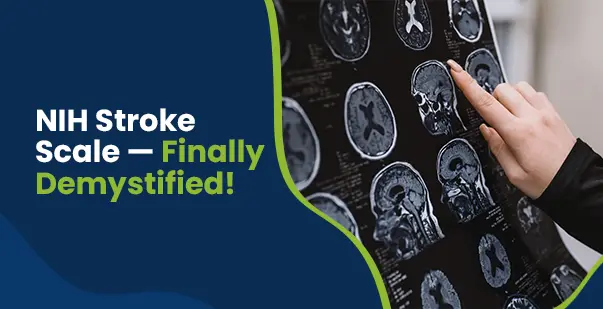Table of Contents:
- Introduction
- What Is the NIH Stroke Scale?
- How to Use the NIH Stroke Scale?
- Why the NIH Stroke Scale Matters After CPR?
- Which Areas Are Evaluated Using the National Institutes of Health Stroke Scale (NIHSS)?
- The Role of NIHSS Pictures and Visual Tests
- Pursue the Right NIH Stroke Certification to Detect Strokes
How do healthcare providers quickly and accurately assess the severity of a stroke at the bedside? Simple, they use the National Institutes of Health (NIH) stroke scale to predict patient outcomes easily.
Despite its importance, many still misunderstand or underuse the scale. A common misconception is that the NIH Stroke Scale is just a checklist, but it’s more than that. It’s a structured tool that, when used properly, offers valuable insight into the severity of a stroke and guides timely treatment decisions. So, read on to learn more about the NIH Stroke Scale, clarify common areas of confusion, and get practical tips to make it part of your daily clinical workflow.
What is the NIH Stroke Scale?
The NIH Stroke Scale (NIHSS) is a standard tool used by doctors and nurses to assess the impact of a stroke on a person’s brain. It checks areas like movement, speech, vision, alertness, and coordination to understand how serious the stroke might be.
A 2021 study in the Stroke journal found that consistent use of the NIH Stroke Scale improves early detection, supports faster decision-making, and helps predict patient outcomes more reliably.
Even though it was first developed for research, the NIH Stroke Scale is now used in hospitals and emergency settings every day. It helps healthcare teams speak the same language when discussing a patient’s condition, planning treatment, and stroke management.
The NIH neurological examination stroke scale test is designed to evaluate various aspects of brain function, including consciousness, vision, motor skills, speech, and coordination. This particular test is administered within minutes and helps physicians understand the extent of damage. It also helps them track patient progress over time. The scale is an excellent diagnostic tool that aids in treatment planning and outcome predictions.
How to Use the NIH Stroke Scale?
Healthcare providers who use the NIH stroke scale assessment can record the patient’s performance in 11 categories, such as motor or sensory abilities. Here is a detailed example that specifies the instructions used to determine performance and score correctly on the scale. The following score is used to test the level of consciousness (LOC), which refers to a patient’s awareness of themselves and their surroundings.
The healthcare provider must choose a particular response if a full evaluation is not possible due to obstacles such as language barriers or the presence of bandages. A score of 3 is possible only if the person does not move in response to noxious stimulation. Here is a list of the NIHSS scores for your understanding:
- 0: Alert and keenly responsive.
- 1: Not alert but minor stimulation to answer, obey, or respond may arouse the person.
- 2: Not alert and requires strong, painful, and repeated stimulation to make movements
- 3: Responds only with autonomic or reflex motor effects because the person may be totally unresponsive
Read More: How POTS is Diagnosed & Tested
Why the NIH Stroke Scale Matters After CPR
Cardiopulmonary resuscitation (CPR) is the best way to help victims of stroke in emergencies. It involves performing chest compressions and rescue breaths to maintain blood circulation and oxygen flow in the body. Professionals trying to help victims must also be aware of the important steps of CPR before proceeding.
Once the patient is stable, a thorough NIH assessment becomes the next key step to evaluate neurological function and determine the immediate course of treatment.
The NIH stroke scale evaluates several brain or neurological domains that are often affected during a stroke. Each domain is scored individually, and the total score is calculated by adding up all the points. A lower score generally indicates a milder stroke, while higher scores suggest severe impairment.
Which Areas Are Evaluated Using the National Institutes of Health Stroke Scale (NIHSS)?
With more advanced technology, tools such as mobile apps and e-learning platforms have made it easier to practice and apply the NIH Stroke Scale. These apps include interactive quizzes, video tutorials, and case simulations, bringing flexibility to the learning process.
Currently, the NIHSS stroke scale assesses the following areas:
Level of Consciousness (LOC)
This initial assessment determines the patient’s alertness and ability to respond to stimuli.
How to Use It: The examiner asks questions and gives simple commands, such as opening and closing the eyes or gripping and releasing the hand.
What it Means: An altered LOC may indicate extensive brain damage and help establish a baseline for further assessments.
Best Gaze
This measures voluntary eye movement.
How to Use it: The examiner observes if the patient can track a moving object with their eyes.
What it Means: Abnormal gaze or restricted eye movement may suggest a brainstem or cerebral lesion, which is mandatory for diagnosis and localization of the stroke.
Visual Fields
These components help assess a patient’s ability to see in all areas of their visual field.
How to Use it: Clinicians usually test each quadrant of the patient’s vision to determine if there is any loss of peripheral vision, commonly caused by damage to the optic pathways.
What it Means: A visual field cut can severely impact safety and quality of life and help determine the area of the brain affected.
Facial Palsy
It leads to partial paralysis on either side of the patient’s face.
How to Use it: The examiner looks for asymmetry in the patient’s facial expressions, such as when they smile or show their teeth.
What it Means: Weakness or drooping on one side of the face is a classic stroke symptom that suggests the involvement of the cranial nerves or the facial motor cortex.
Motor Function – Arm and Leg
Each limb is tested separately to determine if there is any weakness or complete paralysis.
How to Use It: The patient is asked to lift each arm and leg for a few seconds.
What it Means: Inability to hold a limb in the air is indicative of motor deficits caused by damage to the corresponding motor cortex in the brain.
Limb Ataxia
This assesses coordination in the limbs.
How to Use It: The finger-to-nose and heel-to-shin tests are used.
What it Means: Uncoordinated or jerky movements can point toward cerebellar damage, even in patients with otherwise strong limbs.
Sensory Function
Sensory testing evaluates the patient’s response to touch and pain.
How to Use it: The examiner uses a pin or similar object on different parts of the body.
What it Means: Absent or reduced sensation on one side may suggest a lesion in the sensory cortex or thalamus.
Language (Aphasia)
Language or aphasia is a key component of the NIH Stroke Scale.
How to Use It: Language skills are evaluated by asking the patient to describe a picture, name objects, and read sentences.
What it Means: Impaired language ability, or aphasia, usually indicates damage to the dominant hemisphere, typically the left side of the brain.
Speech Clarity (Dysarthria)
This measures the patient’s ability to articulate words.
How to Use It: Slurred or unclear speech, while the language is intact, points to dysarthria.
What it Means: This condition may be caused by the involvement of the cranial nerves or cerebellum.
Extinction and Inattention (Neglect)
This test for hemispatial neglect, where the patient is unaware of stimuli on one side.
How to Use it: This is tested by providing simultaneous stimuli to both sides and observing whether the patient responds equally to them.
What it Means: It’s particularly common in right hemisphere strokes and may affect visual, auditory, or tactile awareness.
Read More: Stroke Management: ACLS Certification Guide
The Role of NIHSS Pictures and Visual Tests
Visual tools, such as NIHSS pictures, are often used in stroke training to make learning more effective. These images show real-life examples of stroke symptoms. Using pictures helps learners better understand what each score on the NIH Stroke Scale actually looks like. Instead of just memorizing numbers, they can connect those numbers to visible signs of stroke in patients.
Many training programs now include these visuals along with video demonstrations and stroke picture tests. This approach helps healthcare providers recognize symptoms more accurately and assign the correct scores during real assessments.
Pursue the Right NIH Stroke Certification to Detect Strokes!
The NIH Stroke Scale is used to detect or diagnose strokes. If you’re involved in patient care, especially in neurology, emergency response, or acute care settings, NIHSS certification trains you efficiently. It helps you identify stroke severity with precision, reduce delays in treatment, and communicate findings clearly with the care team.
Look for certification programs that include case-based simulations, video assessments, and practice with NIHSS scoring. Additionally, if you’re often the first point of contact in emergencies, pursue an online Basic Life Support (BLS) certification to add another layer of preparedness!







